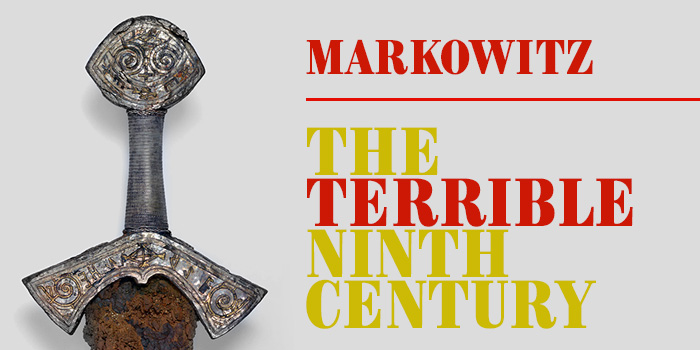
By Mike Markowitz for CoinWeek …..
MOST PEOPLE WHO are not medievalists would be hard pressed to name one thing that happened between the years 800 and 900. For many Europeans during that terrible century, it was the worst of times. Viking raiders descended from the north, Arab marauders attacked from the south, and kingdoms in between were repeatedly torn by dynastic civil wars. Disruption of trade and shrinkage of the economy made coinage in this chaotic era scarce, and like most coins of the so-called “Dark Ages” they are not much to look at.
But they have quite a few stories to tell.
The Franks
On Christmas Day in the year 800 in Rome, Pope Leo III crowned Karl, King of the Franks (742-814), as Emperor of the Romans, a post considered vacant because a woman, Irene, ruled the eastern empire in Constantinople. We know him better by his French nickname, Charlemagne (“Charles the Great”).
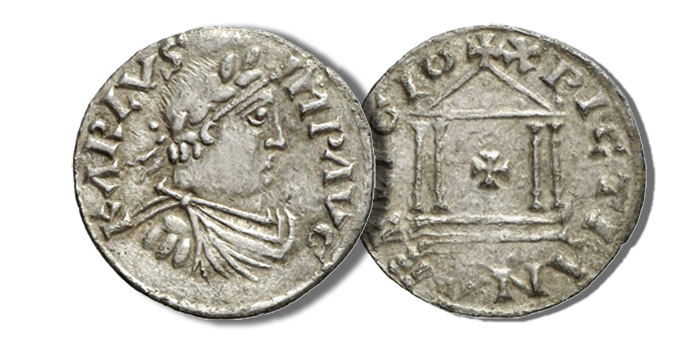
Most coins issued in Karl’s name identify him only as king of the Franks (REX FR). The imperial title (IMP AUG) appears on rare portrait coins, struck either for the coronation in 800 or for the Byzantine recognition of such in 812. At a 2012 Künker auction, this coin sold for 160,000 euros [Approx. $196,568 USD at the time of writing. —CoinWeek] against an estimate of 30,000 [$36,856.50] – a record for a medieval silver coin[1]. There was only one denomination: the silver denier or “penny” of about 1.7 grams (“denier”, of course, coming from the Latin denarius, the long-serving silver coin of Ancient Rome). Initially these were nearly pure silver, but over time, the alloy was debased and the weight varied. Some of Charlemagne’s successors struck half-pennies, often called obols.
Gold coinage largely disappeared from circulation in Western Europe in the seventh century, but a handful of gold “solidus” pieces (about 4.5 grams) in the name of Charlemagne survive, including a specimen in the British Museum (acquired from King George IV in 1825) minted at Dorestad in the Netherlands, an important seaport until Viking raids in the 830s ruined its trade[2].
Over 100 mints across Western Europe struck Charlemagne’s coins. Melle in western France was an important mint, thanks to rich silver mines that were worked extensively from 602 to about 995. Charlemagne’s coins mostly do not bear a portrait, but rather his monogram: the letters K R L S arranged in a cross. A typical, slightly chipped example from Melle brought just over $500 in a 2009 auction[3].
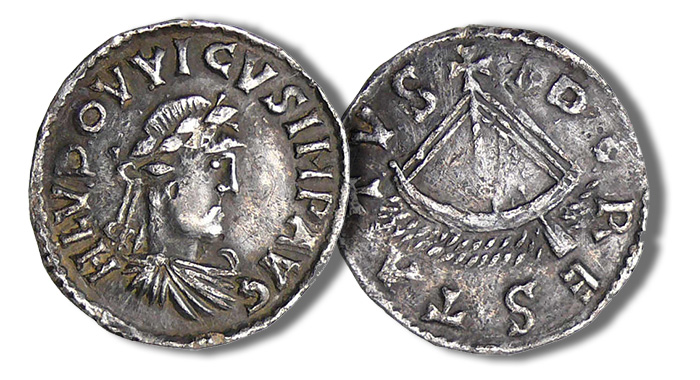
Charlemagne’s sole surviving son, Louis (born 778), nicknamed “the Pious”, succeeded him in 814 and ruled until 840. To prop up his own legitimacy, his coinage mimicked that of his father – including Charlemagne’s portrait.
The reverse of a rare example from the city of Tours shows a crudely drawn city gate[4], recalling coins of the Roman emperor Constantine (ruled 306-337) and his successors. Louis’ name is written HLUDOVVICUS (ninth-century spelling was erratic). A rare issue from Dorestad shows a ship on the reverse[5].
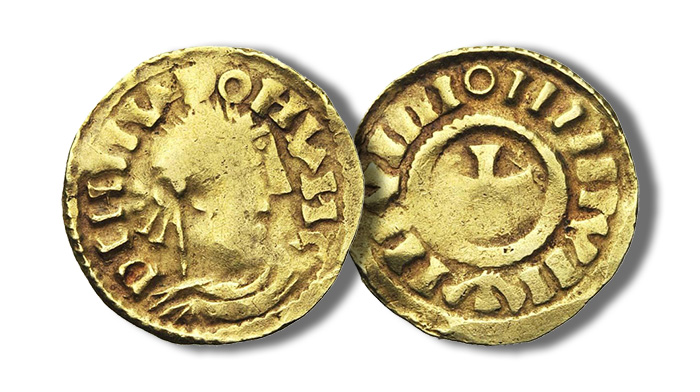
Most surviving gold coins in the name of Louis are barbaric imitations from Frisia (the North Sea coast of the Netherlands and Germany, a borderland of the empire). The reverse inscription MUNUS DIVINUM (“Divine Gift”) becomes a decorative border of meaningless strokes[6].
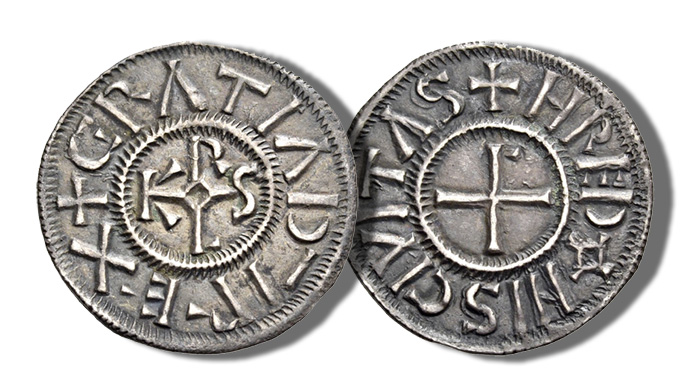
Born in 823, Charles “the Bald”[7] (Charles le Chauve in French, Karl der Kahle in German), youngest son of Louis the Pious, came to the throne in 840 on the death of his father. A complex civil war against his brothers ended in 843 when the Treaty of Verdun gave Charles most of France. Lothair (the eldest son, ruled 817-855) received much of Germany, and Ludwig (“Louis the German”, ruled 817-76) got a buffer zone in between, running from the Netherlands to Italy. Some coins of this period bear Latinized mint names, with the KRLS monogram and a cross in a circle[8]. But many depict only a stylized church surrounded by the inscription XPISTIANA RELIGIO (“For the Christian Religion”)[9].
Following the death of Charles in 877, the empire went into rapid decline, torn by dynastic squabbles and Viking attacks. Charles the Fat, son of Louis the German, briefly ruled a reunited empire (881-888). His coins are indistinguishable from those of Charles the Bald, since they bear the same name. In 886 Paris withstood a long Viking siege and Count Odo (or Eudes), leader of the defense, was chosen as king by the Frankish nobles.
Anglo-Saxons
At the beginning of the ninth century, Mercia was the dominant Anglo-Saxon kingdom of England and Coenwulf (pronounced “Kenwulf,” ruled 796-821) was its king. His coinage of silver pennies was struck at London and later also at Canterbury and Rochester. An example brought over $3,500 in a recent auction[10].
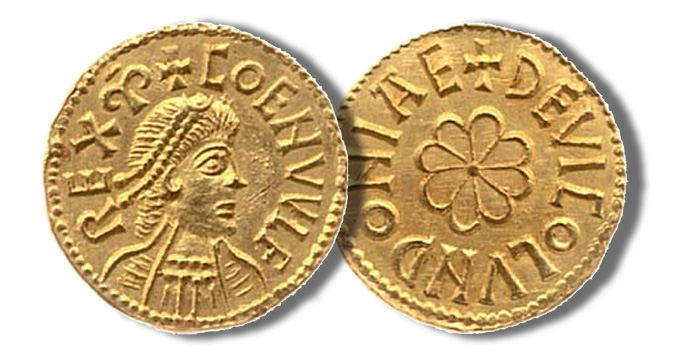
In 2001, a metal detectorist found a magnificent gold portrait coin of Coenwulf “next to a public footpath beside the river Ivel, Bedfordshire.” This was only the eighth Anglo-Saxon gold coin of this period to be discovered. Known as a “mancus” and valued at 30 silver pence, these rare pieces were struck on special occasions, mainly for donations to the Church. Sold to an American dealer at auction[11], the coin was considered a national treasure, and eventually acquired by the British Museum.
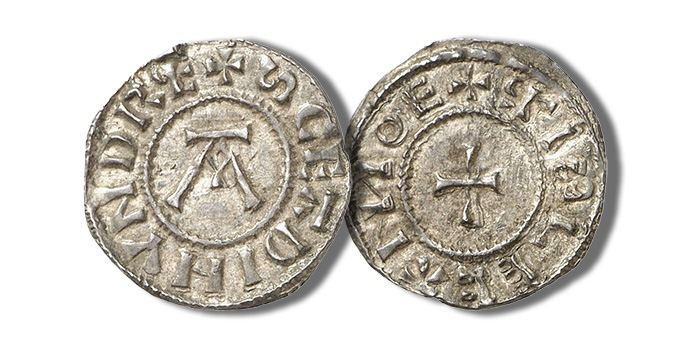
Edmund became king of East Anglia in 855, and almost nothing is known about his reign. According to legend, in 869 when the Danes invaded England, they captured him:
…after he refused the Danes’ demand that he renounce Christ: the Danes beat him, shot him with arrows and then beheaded him.[12]
A rare silver penny of Edmund from an uncertain mint brought $1,700 in a recent auction[13]. More common are the “memorial” coins issued in Edmund’s name (c. 890-905) by descendants of the very Danes who killed him, after they converted to Christianity and established a local kingdom. The coins bear a prominent letter A for “Anglia”[14].
The only British monarch to earn the title of “the Great”, Alfred of Wessex (born 849, ruled 871-899) is among the most famous personalities of the ninth century, and his scarce portrait coins are highly valued.
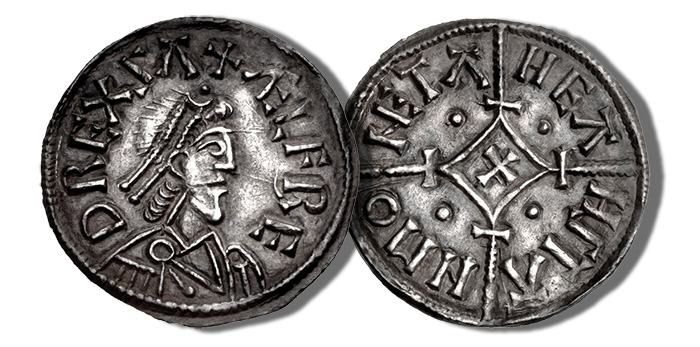
The youngest of four sons, he outlived his brothers despite chronic health problems. In 865, a Danish invasion–“The Great Heathen Army”–threatened to conquer all the squabbling Anglo-Saxon kingdoms that made up England at the time. In a series of hard-fought campaigns, Alfred defeated the invaders, agreed to divide the land with them, and even managed to convert the Danish king Guthrum to Christianity[15].
Coin portraits of Alfred shows him wearing a diadem, the golden headband that was an ancient symbol of kingship. A superb example found in 2015 sold for $42,500 in a recent US auction[16].
In 886, Alfred reoccupied and rebuilt London, which had been sacked and burnt by Viking raiders in 851. A monogram of the city’s name appears on some of Alfred’s coins, accompanied by the name of the moneyer[17]. A rare example brought $25,000 in a recent auction[18].
Perhaps the most remarkable coin of Alfred is a unique piece in the British Museum that was found at Croydon Palace[19]. The coin is chipped, but the inscription can just barely be made out: +AELFRED REX ANGLOR+ (“Alfred King of the English”). This is the first and only occurrence of this title on an Anglo-Saxon coin. The reverse is even more extraordinary. Two haloed, enthroned figures hold a globe between them, while a winged angel (or Nike, goddess of victory?) hovers above them. This exact image appears on the reverse of some late fourth-century Roman gold coins from Western mints, and would have been familiar to Anglo-Saxon moneyers from Roman coins found in England.
The coin clearly was struck to commemorate some special occasion, but we have no idea what it might have been…
* * *
Notes
[1] Künker Auction 205, 13 March 2012. Lot 1405.
[2] https://en.wikipedia.org/wiki/Dorestad
[3] Jean Elsen Auction 101, 13 June 2009. Lot 347. Realized $504 USD
[4] Sincona Auction 6, 23 May 2012. Lot 246. Realized $7,073 USD
[5] Monnaies d’Antan Auction 18, 21 November 2015. Lot 496. Realized $5,651 USD
[6] Jean Elsen Auction 127, 5 December 2015. Lot 660. Realized $4,355 USD
[7] It has been suggested that Charles’ nickname was used ironically and not descriptively; i.e. that he was not in fact bald, but rather that he was extremely hairy.
[8] Nomos Aunction 14, 17 May 2017. Lot 477. Realized $306 USD
[9] Dix Noonan Webb Auction 144, 21 February 2018. Lot 481. Realized $335 USD
[10] CNG Triton XX, 10 January 2017. Lot 491. Realized $3,550
[11] Spink Auction 4018, 6 October 2004. Lot 493. Realized £200,000 ($355,935 USD)
[12] https://en.wikipedia.org/wiki/Edmund_the_Martyr
[13] CNG Triton XIX, 5 January 2016. Lot 891
[14] Künker Auction 274, 15 March 2016. Lot 3103. Realized $945 USD
[15] https://en.wikipedia.org/wiki/Guthrum
[16] CNG Triton XX, 10 January 2015. Lot 1526
[17] “Moneyers” were private contractors who produced coins for medieval rulers.
[18] CNG Triton XIX, 5 January 2016. Lot 911
[19] Registration number 1896.0404.63; “Not on display”
References
Blackburn, Mark. “Money and Coinage”, The New Cambridge Medieval History, Volume 2. Rosamond McKitterick (ed.). Cambridge (1995)
Dolley, Michael. Anglo-Saxon Pennies. London (1964)
Grierson, Philip and Mark Blackburn. Medieval European Coinage 1: The Early Middle Ages. Cambridge (1986)
–. Coins of Medieval Europe. London (1991)
McCormick, Michael. “New Light on the Dark Ages: How the Slave Trade Fueled the Carolingian Economy”, Past & Present 77 (2002)
McEvedy, Colin. Penguin Atlas of Medieval History. London (1961)
Naismith, Rory. “Spending Power: Money and Power Relations in Early Modern Europe”, Uppsala University Coin Cabinet Working Papers 16. Uppsala, Sweden (2015)
Thompson, James W. “The Commerce of France in the Ninth Century”, Journal of Political Economy 23 (1915)
Walker, Ralph S. Reading Medieval European Coins. Fairfield, CT (2009)
NGC-Certified English Silver Pennies Currently Available on eBay
[wpebayads]




